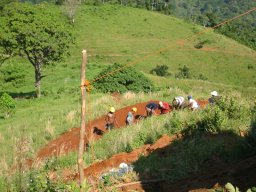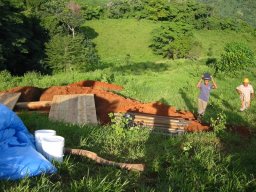Introduction
Cerro Dorado is a new discovery made during the Gold Fields funded generative exploration programme. Geological mapping, soil and channel sampling produced highly anomalous results in gold and copper. Soil sampling defined an approximate 1,500 by 1,100 metre area highly anomalous in gold. This was followed up by a series of semi-continuous channel samples across a mineralised diorite intrusion that returned significant mineralised intervals including 20 m @ 6.17 g/t Au and 41 m @ 1.40 g/t Au. These channel samples were followed up with a short drill programme that intersected 22.86m @ 2.91 g/t Au, including 12m @ 5.29 g/t Au and 46 m @ 1.34 g/t Au including 20m @ 2.71 g/t Au.
Target Minerals: Gold & Copper
Location & Access
The project is located in the Monsenor Noël province one and a half hours drive from the country capital Santo Domingo. Access is excellent with a paved highway crossing the project.
Ownership
The Cerro Dorado project is 100% owned by GoldQuest.
Geology
Cerro Dorado was discovered during the Gold Fields-funded regional exploration program. Several strong gold stream sediment anomalies were followed up and a sample from a large boulder of replacement silica-pyrite taken during the sediment program returned 491 g/t Au (15.2 oz/t) and 7.69% Cu. A second rock float sample of quartz vein returned 65 g/t Au. The area was followed up with geological mapping, soil sampling, channel sampling and two short rounds of exploration drilling.
While the source of the high-grade float has not been identified, follow up work defined a large gold-in-soil anomaly with an area of approximately 1,500 m by 1,100 m. The highest values in soils are 2.01 g/t Au and 1.3 g/t Au, with an average gold value of 0.29 g/t Au from 38 samples above 0.1 g/t Au (out of a total of 479 soil samples).
GoldQuest geologists completed a north-south trending line of channel samples across an altered quartz diorite intrusion with a quartz veinlet stockwork exposed in a stream. Mineralization is interpreted to be possible porphyry gold style.
Composite sample grades from the channel sampling are as follows:
Drilling
A diamond drill programme was completed in the area of the anomalous channel samples testing the western contact of the mineralised diorite exposed in a creek that had been channel sampled. The zone of anomalous channel samples that returned 20 m @ 6.17 g/t Au was tested with three holes (CD01, 02 & 03) with two further holes (CD04 & 05) drilled approximately 85 metres to the south of holes CD01 and 02 in an area that returned 41 m @ 1.40 g/t Au. All holes were drilled on a 100% owned GoldQuest concession.
Holes CD 01, 02, and 04 all intersected strongly altered and oxidised diorite with a highly variable quartz-magnetite vein stockwork before intersecting weakly mineralised chlorite schists at depth. The drilling defined the intrusive contact as shallow implying possible tilting of the body. Drill holes CD 03 and CD 05 intersected late mineral porphyry with no significant results.
Drill results are summarised in the table below
| Mineralized Interval (Meters) |
Average gold grade Grammes per tonne |
| 20 | 6.17 |
| 12 | 7.13 |
| 9 | 0.48 |
| 6 | 1.15 |
| 41 | 1.40 |
| 9 | 1.23 |
| 8 | 0.82 |
| 11 | 1.28 |
| Hole No. | From (m) | To (m) | Interval (m) | Au (g/t) |
| CD01 (Including) |
0.00 2.00 |
22.86 14.00 |
22.86 12.00 |
2.94 5.29 |
| CD02 | 0.00 | 20.00 | 20.00 | 2.70 |
| CD04 (Including) |
4.00 4.00 |
50.00 24.00 |
46.00 20.00 |
1.34 2.71 |


